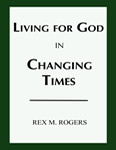Mass shootings are rare but all too commonplace. While this sounds contradictory, it is true, so why are there more mass shootings now than say, fifty years ago?
Hi, I’m Rex Rogers and this is episode #232 of Discerning What Is Best, a podcast applying unchanging biblical principles in a rapidly changing world, and a Christian worldview to current issues and everyday life.
Mass shootings are now a regular if periodic event in contemporary life. For some perspective, it’s interesting to note right at the top that “mass shootings make up only 1% of all gun violence in America. 60% of gun deaths are suicide and 37% are homicide — including the 1% of mass shootings.
“Suicides have long accounted for the majority of U.S. gun deaths.” The remaining 3% of gun deaths include law enforcement involved shootings, unintentional shootings, and those that were undetermined.
But mass shootings get our attention, in part for the body count and in part for the fact that much of the carnage seems aimed at innocent, unsuspecting people, so for good reason we get the idea this could happen to anybody, to us, to ours. What do we know about mass shootings?
Most definitions describe a mass shooting as an event where there are four or more people shot or killed in a 24-hour period and not involving gang violence or terrorism.
- The U.S. accounts for 31% of the world’s mass shootings, despite making up only 4-5% of the global population.”
- U.S. mass shooters are "overwhelmingly (98%) male”—"around 34 years old.”
- 55% of mass shooters are White, 21.3% Black, 9.1% Hispanic, 5.4% Asian.
- Workplaces are the site of 28% of mass shootings, followed by schools at 22%., about 4.3% in places of worship.
- Rifles, or as media like to repeat, “AR-15 assault rifles,” are not the primary weapon of mass shooters. (The "AR," by the way, stands for ArmaLite Rifle, not "assault rifle.")
- Handguns are used in 73% with rifles used in 33% of mass shootings.
“While 73% of all mass shootings occur in developed countries, why are so many incidents reported in the US?
A now familiar list of variables includes, “the nation’s high civilian gun ownership, cultural factors like individualism and fame-seeking, sensationalized media coverage, and gaps in mental health care and law enforcement.”
“Most mass shooters target places they know well—schools, workplaces, or other familiar settings—because they have a personal connection and personal grievance. More than a third of mass shooters have histories of domestic abuse rooted in issues like anger, masculine entitlement, and a desire for control. Many mass shooters have experienced traumatic childhoods, including physical, emotional, and sexual abuse, parental drug use and incarceration, and domestic violence.”
The mass shooters are not typically transgender, but a few high profile shooters have identified as “transgender” or “gender fluid,” for example, Aberdeen, MD (2018), Perry, Iowa (2024), Highlands Ranch (2019) and Colorado Springs (2022) Colorado, Nashville (2023), Minneapolis (2025). As yet, evidence is inconclusive in part because key perpetrator characteristics are hidden from media or buried in police investigations or non-investigations.
There are a number of contributing factors. Social and cultural aspects of US culture: despair, anger, and resentment. Extremist websites and groups can provide a sense of community and belonging that many shooters lack. This sense of belonging and welcome may be more important to the shooter than any kind of ideology.
Mass shootings can be considered a form of suicide. Few mass shooters have a realistic plan, if any plan at all, for escape following a shooting.
Much of the debate about mass shootings revolves around two perspectives: human evil is the root cause vs. guns are the root cause. But it is easy to make the case that availability of guns creates opportunities for violence, but the issue is complex. For one thing, guns have always been part of American society, always available, and for a long time considered essential equipment for every household, yet mass shootings did not occur.
Research by criminologist Grant Duwe indicates that “prior to 1965, there (were) relatively few mass public shootings in the United States.”
Consider this: in the US one mass shooting occurred in the 1950s, in the 1960s six, in the 1970s thirteen, in the 1980s thirty, in the 1990s forty-two. “From 2000 to 2013, there were 53 mass public shootings in the United States.”
So, mass shootings have been surging up for the last fifty years. “Familicides are by far the most common form of mass murder, making up nearly 45% of all mass killings since 1976. Familicides most often involve a male head of the household killing his partner (i.e., spouse, ex‐spouse, fiancée), their children, relatives, or some combination of these. Felony‐related massacres are the second most common type of mass murder. These incidents typically involve a small group of young men who commit mass murder during a robbery”
So, what has changed since the 1950s, if it’s not the availability of guns?
One major and obvious change is that American culture began to jettison its engagement with religion, specifically the moral codes of Christianity like “Thou shalt not kill’ (Ex. 20). Mass murderers are not church-goers and typically do not have strong family or community relationships. They are loners.
Dennis Prager of Prager U adds that another change since the 1950s is a drop in the number of marriages. Married men are not all what they should be, but marriage does create outlets for male energy and interest. Typically, marriage, even difficult ones, mature us. Mass murderers are generally not married.
Male role models have declined—partly via absent fathers—or male role models have been systematically denigrated by entertainment and societal elites, so boys have fewer real men, mature men to emulate. Some sources claim that as many as 72% of adolescent murderers and 70% of long-term prison inmates come from fatherless homes. Another study found that 85% of youth in prison come from fatherless homes.
Running for the presidency in 2008, Senator Barack Obama said, “Children who grow up without a father are five times more likely to live in poverty and commit crime; nine times more likely to drop out of schools and 20 times more likely to end up in prison.” He also famously stated, "What makes you a man is not the ability to have a child—it's the courage to raise one."
Then there is another factor that may play a larger role in mass shootings than we’ve so far been able to determine. Youth are taught that America is untrustworthy, indeed it is despicable, a colonizer, an oppressor. Their country is not worth their respect and in fact is a convenient source for blaming all their problems.
So young men and women grow up without religion and without country and without meaning. They are rootless and angry for reasons they do not understand. Boys who should be becoming men remain immature and develop hateful outlets for their aggression. Girls who should be becoming women remain immature and develop online addiction, depression, and at times unhealthy relationships with men who aren’t what they should be.
Of course, not all these youth turn into mass shooters. But it only takes one young man whose circumstances are especially dire, whose grievances are peculiarly intense, whose contacts are particularly toxic, whose sense of victimhood is unusually high, and whose killer opportunities are terribly present and easy to access.
Every gun in America could somehow be eliminated, but we’d still have mass killings. Maybe not with as high of body counts, but the evil in human hearts is still there and Satan is still working to spread confusion, sickness, death, and havoc in the world.
What America needs is what we’ve always needed. “For the wages of sin is death, but the free gift of God is eternal life in Christ Jesus our Lord” (Rom. 6:23).
Well, we’ll see you again soon. This podcast is about Discerning What Is Best. If you find this thought-provoking and helpful, follow us on your favorite podcast platform. For more Christian commentary, see my website, r-e-x-m as in Martin, that’s rexmrogers.com, or check my YouTube channel @DrRexRogers.
And remember, it is for freedom that Christ has set us free. Stand firm.
© Rex M. Rogers – All Rights Reserved, 2025
*This podcast blog may be reproduced in whole or in part with a full attribution statement. Contact me or read more commentary on current issues and events at www.rexmrogers.com/ or my YouTube channel @DrRexRogers, or connect with me at www.linkedin.com/in/rexmrogers.


